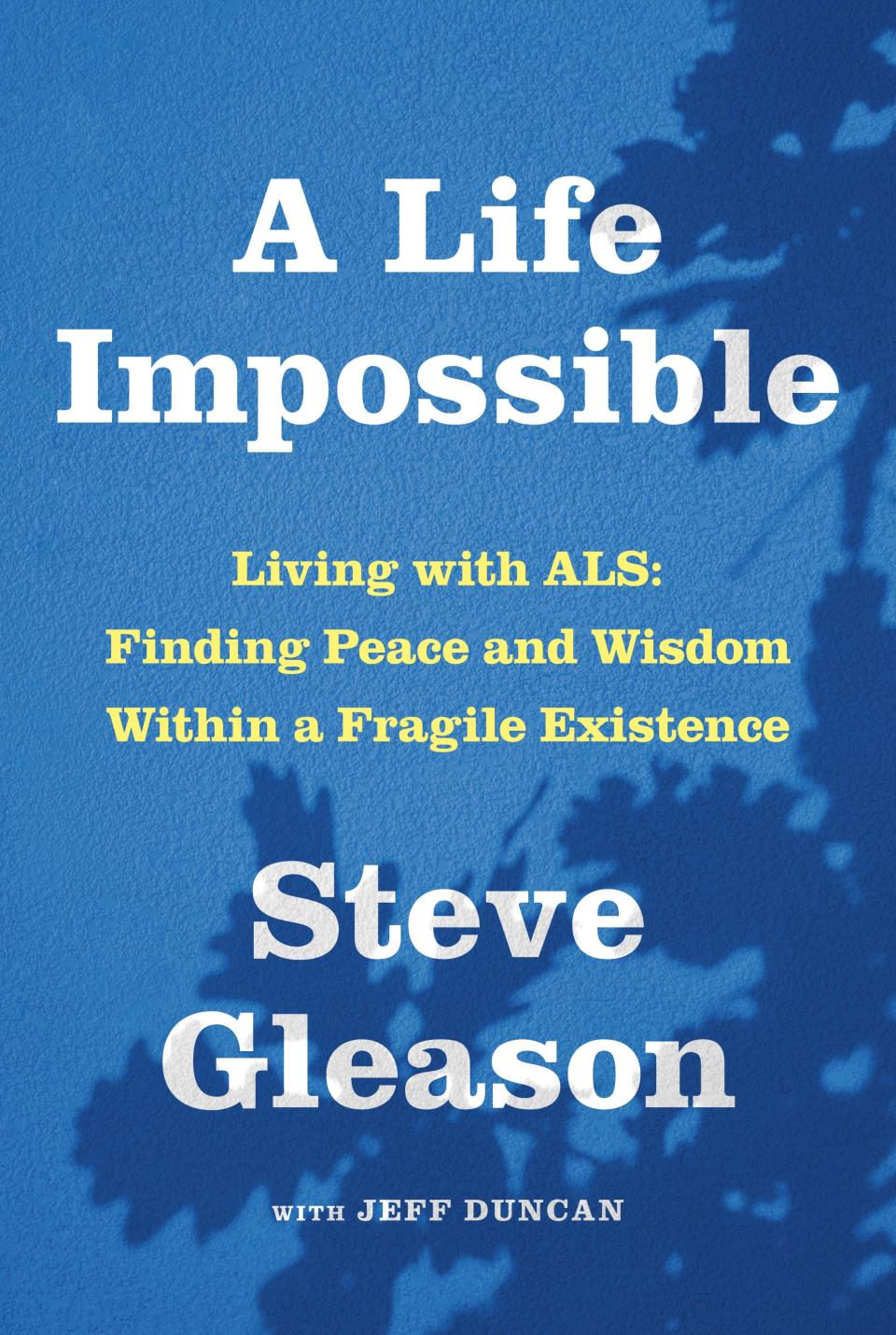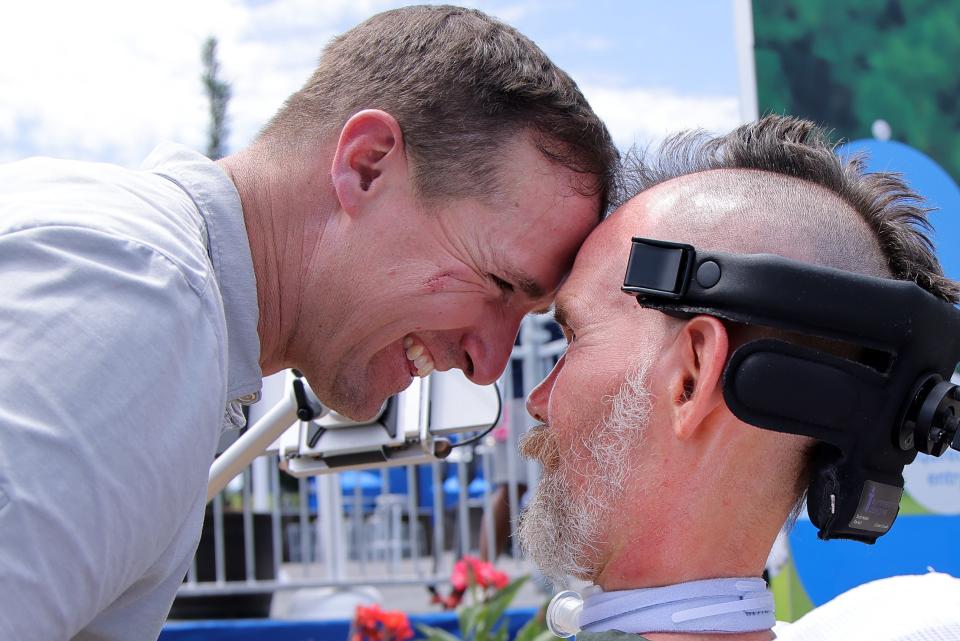Steve Gleason Isn’t Just Staying Alive. Steve Gleason Is Living

Getty Images; Gabe Conte
This story was featured in The Must Read, a newsletter in which our editors recommend one can’t-miss story every weekday. Sign up here to get it in your inbox.
An oblong object sails through the New Orleans air. Along with countless others, Steve Gleason stares as it hangs for a long moment at the top of its arc, and then begins to fall, tumbling in what seems like slow motion. There’s a feeling of pent-up delirium, the gathered crowd ready to explode.
Maybe you’re thinking of a certain Monday Night Football game in 2006. On that night, the first for the New Orleans Saints back in the Superdome after Hurricane Katrina, Atlanta Falcons punter Michael Koenen prepared to send the ball downfield just as Gleason, the undersized, undrafted special teams player for the Saints, broke through. All but horizontal, hair flowing from beneath his helmet, hands together as if in praise, he batted the ball down to the turf, delivering a touchdown and marking an end to the team’s long exile. It was a moment so explosive, so cathartic, so chill-inducing that it’s been immortalized in a statue outside the Dome’s gates.
But this is not that Monday. It’s a warm spring afternoon just last week, in the midst of the New Orleans Jazz & Heritage Festival. This is not that crowd. They are not dressed in black-and-gold, but dirt-smeared tank-tops and shorts. They are gathered for an annual, semi-secretive event known as the Jazz Fest Triathlon, the highlight of which is an arcane bacchanalian ritual known as the Watermelon Sacrifice. And the airborne object Gleason tracks through the sky this time is not a football but rather said watermelon, bright, plump, and green and hurtling its way down toward the scrubby ground.
Above all, Gleason is not the same person he was on that famous September night. It has been 16 years since he retired from football; 13 years since he was diagnosed with amyotrophic lateral sclerosis (ALS, or Lou Gehrig’s Disease); 12 since he began using a wheelchair and had his last solid food; 10 since he required a tracheotomy to keep breathing. He is, he likes to say, “ten years past my expiration date.” And yet here he is, as he has been for the past twenty Watermelon Sacrifices, beaming with the rest of the crowd as the melon, hurled skyward this year by Gleason’s own 12-year-old son, Rivers, plunges back to earth and bursts into a mess of red and green pulp that is immediately set upon by the cheering crowd.
One way to understand Gleason is that his equally devastating and inspiring new memoir, A Life Impossible: Living with ALS: Finding Peace and Wisdom Within a Fragile Existence, devotes as many words to the Watermelon Sacrifice as it does to the Blocked Punt.
“The punt may be synonymous with triumph on the football field,” he told me, through an exchange in which I emailed questions and he painstakingly typed answers on a tablet that he controls with eye movements. “The Watermelon Sacrifice represents triumph of a different kind. It's a symbol of everything I love about New Orleans and its people, my family. It's a celebration of life's imperfect beauty, and the enduring spirit of a city that has captured my heart.” It is also the event where he met his wife, Michel Varisco Gleason, beginning a great and difficult love story that is the emotional heart of A Life Impossible.

Gleason’s insistence on remaining connected to the bloodstream of New Orleans culture has kept him as much of a folk hero in the Crescent City now as he was following his most famous football play. His distinctive chair is a frequent sight around town. In the past few weeks alone, he’s debuted a collection of art he created using AI prompts; he’s appeared at the Zurich Classic golf tournament; and, of course, he was at the Watermelon Sacrifice. Last year, in the midst of Mardi Gras, he paraded down the five-mile route of the Krewe of Orpheus parade. Meanwhile, his organization, Team Gleason, has raised tens of millions of dollars to support ALS patients; he has been a force behind the development of the technology that allows him to continue to communicate; and he has been among the country’s most visible advocates for medical research into the disease. It’s all part of a tireless commitment not only to staying alive—a monumental act of will and fortune in its own right—but to living.
But scratch that: If there is one thing that A Life Impossible makes repeatedly clear, it is that while Steve Gleason is indefatigable, he is not tireless. He gets tired. And depressed. And frustrated. And worse. Gleason makes no secret of the suffering necessary to reach even fragmentary moments of wisdom and acceptance. His book doesn’t just gesture to the wilderness in which Gleason has done his time, but makes you feel every thorn. As he says, “I’ve got wilderness tattooed all over me.”

There’s a Team Gleason van parked in the driveway when I come to visit Gleason’s home in a suburban section of the city. (We have not met before, but I am friends with his co-writer, Jeff Duncan, and I read some of A Life Impossible in early drafts.) The Gleasons have two children, Rivers, 12, and Gray, 5. A pair of kids’ bikes lean up against the garage, and the living room is in a state of Friday morning familial disarray.
Gleason has invited me to watch what he calls his “morning workout,” a callback to his athlete days that now refers, with what I’ll soon realize is something of an arched eyebrow, to the routines necessary to launch him into each day.
I find him in the bedroom, along with two of his three full-time caregivers, Jenni Doiron and Beau Baker. Gleason is lying on the bed, thin legs bent to the side, wearing a blue t-shirt bearing one of his mottos: NO WHITE FLAGS. A towel is draped across his lower body. His nails are painted in various patterns of blue and white; performing manicures is one of his daughter’s favorite pastimes. Away from his tablet for the duration of the workout, Gleason communicates using a low-tech solution called a letter board, also known as an eye gaze board, in which the alphabet is split up into six sections. Gleason spells words by moving his eyes around the imaginary board hanging between him and his attendants. One eye movement indicates the proper square, the next, the correct letter. (His quotes here come via this method, our emails, or the electronic voice produced by his tablet.) There’s a copy on the wall next to Gleason’s bed, though everybody here has the board memorized; Baker has been working with Gleason for four years, Doiron since 2011.
Each stage of Gleason’s care is choreographed and rehearsed down to the slightest detail. A large part of the morning consists of the daily effort to empty his bowels, a basic necessity that is made infinitely more complicated by his body’s loss of muscular strength. Before I arrived he received an enema and now Baker leans over him in the bed, pressing his fists deep into Gleason’s abdomen. When they first began this routine together, Gleason had to continually demand that Baker press harder, until his fist practically touched Gleason’s spine; Baker was scared of killing his client.
When Gleason signals that the time might be nigh, Baker disconnects his ventilator, setting off some pings of alarm from the machine. “He’s good for a solid minute,” says Doiron, which is not as reassuring as it might be for a newcomer. In fact, Gleason has trained himself to hold his breath, with the proper preparation, for as long as three-and-a-half minutes and would like to push it even further, a point of contention between him and his caregivers. Baker lifts Gleason from the bed, his body briefly dangling like a coat on a hanger. Baker settles him onto a plastic seat designed to function as both toilet and shower chair, and reconnects his breathing tube to something called a cough assist machine, which helps clear out his lungs. Baker departs to make the day’s smoothies which will be administered via a feeding tube in Gleason’s chest. Gleason’s sense of taste is intact and very occasionally his attendants will put something in his mouth—a beer, soy sauce—to deliver a little flavor, before suctioning it out. For all that, eating is not high on the list of things he misses from his past life. “I’m not sure why,” he says. There is one exception: “I lust over sushi.”
Now, Doiron takes over the bowel program. Planting her feet and leaning forward on her toes, she drives her fists into Gleason’s stomach. Grunting and straining, Gleason guides her hands with his eyes. A white bloom of foam appears at his mouth and a stream of mucus runs from his nose. The mouthguard that keeps his tongue in place falls out and Doiron pops it back in. In his line of sight across the room is a photo of Gray and Rivers. If he could turn to his left, he would see a statue of Buddha in the backyard; to his right a small figurine of Yoda on the dresser, seated in much the same position. The process goes on for about ten minutes before a series of unmistakable noises and smells indicate the job is complete.
Gleason rests. He is still able to manage a half-smile and he cocks one at me now. He indicates with his eyes that he’s going to start spelling something for Doiron to tell me. His eyes flicker as she deciphers each letter.
“C-H-A-P-T-E-R.” A pause. “O-N-E.”

Zurich Classic of New Orleans - Previews
Indeed, A Life Impossible begins in much the same place: with a visceral description of Gleason’s morning. If what Gleason has chosen to show me of his life has seemed startlingly intimate and uncomfortable, the scene in the book is made yet more so by the presence of then-three-year-old Gray sitting on the floor, crying inconsolably while Gleason all but self-immolates with frustration at being unable to help her. It’s at that point you realize that this will not be an ordinary ex-athlete’s inspirational memoir. Instead, A Life Impossible is about Gleason’s search for peace through philosophy and spirituality, but it also demands that the reader bear witness to the blunt realities of his day-to-day life. Nowhere is this more true than in the chapters detailing the burdens that Gleason’s disease places on he and Varisco Gleason’s marriage. Making extensive use of text-message exchanges between the two, the book often gives you the queasy feeling of eavesdropping on a couple’s most private moments.
“Michel and I consciously chose to open up about our journey, knowing the risks involved. Those difficult, truthful, and compassionate conversations were our redemption, and our healing,” Gleason says. “Writing this book was an exercise in vulnerability and imperfection, with the intention of offering kinship with those navigating the foggy unknown.”
By now, Doiron has brushed Gleason’s teeth, showered him, and delivered a vigorous brushing of beard and mohawk. When it is over, Doiron places her forehead to Gleason’s, pressing their heads together and maintaining eye contact for several long seconds. This is known in Gleason World as “Fo to Fo, Mofo” short for “forehead to forehead, motherfucker.” It’s an all-purpose gesture of connection that Gleason has developed to replace all the other forms of contact that are no longer possible. Baker lifts Gleason into his wheelchair, finally reconnecting him to the sliver of autonomy he still enjoys. Gleason worked with Microsoft and a company called Tolt Technologies to develop software and an eye sensor that allow him to use the Internet, move his chair, speak in an electronic voice, and control elements of his environment such as lighting and the TV. In the absence of a medical cure for ALS, Gleason considers this technology its nearest equivalent. “Most of what ALS takes away, technology can give back,” he says. “Without it, instead of being a productive member of society and a pretty badass father, I would be dead. I would call that a cure.”
We gather around the kitchen table. There’s an indoor basketball hoop nearby and sports equipment scattered about. Gray is an eager gymnast, but Rivers enjoys ball sports, raising the inevitable question of whether the Gleasons will allow him to play tackle football. The link between head injuries and ALS remains an open question, but several studies indicate that they could carry increased risk. For the moment, Michel Varisco Gleason says, Rivers has shown more interest in other sports. “We’re not a huge football house,” she says. “Steve is somebody who didn’t even know the Saints had signed Reggie Bush—while he was playing for the Saints.”
In his book, Gleason anticipates the question and writes that he would like to advocate for flag football to become an official high school sport. But, he says now, of the possibility of Rivers playing the more violent version of the game, “It’s not a hard no.”
Difficult topics are not only not taboo here, but surprisingly welcome. “Steve-O loooves to talk about mortality,” says Varisco Gleason, as we gather around the kitchen table. Any number of medical accidents—from sepsis to an attendant sleeping through the alarm that would indicate his respirator has fallen out—could kill Gleason. But it is also likely that the end will come on his timetable, when he decides it is no longer bearable to go on. Gleason has been developing a document called The Impermanence Project, a kind of extensive living will, and has issued explicit requirements for his remains.
“He wants his ashes spread in like seven different places,” Varisco Gleason says. “A few years ago, he had a bout of sepsis and it looked really bad. My first thought was, ‘No. This can’t happen! I don’t know the seven places!’”
The subject has recently taken on more urgency because Gleason’s eyes, which are his primary tool of communication, begin to weaken. Doiron delivers regular applications of special eye drops, made using Gleason’s own blood, in an attempt to keep his eyes lubricated. A possible future step would be neural implants, of the kind being developed at the University of California San Francisco and by the private company Neuralink, that could connect his brain directly to a computer. The fear, though, is that Gleason could find himself “locked in” before that’s possible.
For now, the increased difficulty leaves him more frequently frustrated and, on his worst days, more inclined to raise the possibility of giving up.
“He gets it off his chest, and makes everybody anxious for a little while, and then he’s fine,” says Varisco Gleason. “I think knowing that he has the option to say, ‘Eff this. I’m out of here,’ is helpful. It gives you a sense of control. And also to be surrounded by people being like, “Okay, you can say it, but it ain't happening right now.”
Gleason’s eyes dart across his tablet. “I feel a lot of regret that I’ve said those things to you,” he says. “Dropping bombs.”
“Steve, that’s very nice of you, but it’s part of how you get through. Please let us joke about it and not feel bad,” Varisco Gleason says. “I mean, you can feel a little bad.”
I say something about feeling sheepish about the things I throw tantrums about with my own family. “Life is not about comparisons,” Varisco Gleason says, with the authority of somebody who seems to know. “Don’t compare yourself to Steve because you’ll never win.”
The laughter around the table is loose and unfettered, and barely of the gallows variety. This, it feels, is the reward for the Gleasons’ radical honesty—in A Life Impossible, with me, and with others—about the challenges of what has befallen them.
“I’ve come to understand that true peace arises from being present and accepting our circumstances in each moment, without resistance,” Gleason says. It’s an absurd ask of anybody, much less himself, but to spend time with him and his family is to start to believe that it is the attempt that makes all the difference.
Somehow the subject of Gleason’s first full season with the Saints comes up. It was 2001 and he had been released after only three games the previous year—the most reasonable outcome for a player of his size and promise. Then, at the last second, the call came: a player he declines to name for fear of embarrassing him had shot himself in the knee while cleaning his gun. Gleason took the last spot on the roster.
“I mean,” exclaims Varisco Gleason, without the slightest irony. “Who’s luckier than that!”
Originally Appeared on GQ

